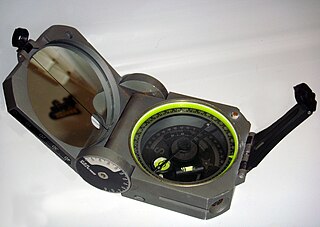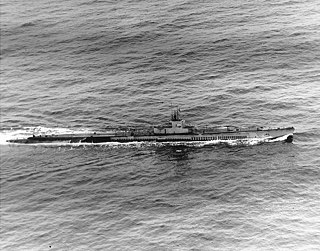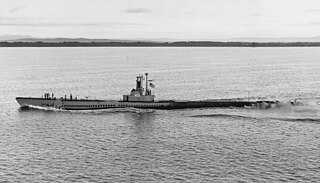
In navigation, bearing is the horizontal angle between the direction of an object and another object, or between it and that of true north.

Apparent wind is the wind experienced by a moving object.

USS Wahoo (SS-238) was a Gato-class submarine, the first United States Navy ship to be named for the wahoo. Construction started before the U.S. entered World War II, and she was commissioned after entry. Wahoo was assigned to the Pacific theatre. She gained fame as an aggressive and highly successful submarine after Lieutenant Commander Dudley Walker "Mush" Morton became her skipper. She was sunk by Japanese aircraft in October 1943 while returning home from a patrol in the Sea of Japan.

The USS Tunny (SS/SSG/APSS/LPSS-282) was a Gato-class submarine which saw service in World War II and in the Vietnam War. Tunny received nine battle stars and two Presidential Unit Citations for her World War II service and five battle stars for her operations during the Vietnam War.

USS Whale (SS-239), a Gato-class submarine, was the second ship of the United States Navy to be named for a whale, an extremely large, aquatic mammal that is fishlike in form. The USS Cachalot (SS-170) commissioned on 1 December 1933 preceded the Whale.

USS Tautog (SS-199), a Tambor-class submarine, was the first ship of the United States Navy to be named for the tautog, a small edible sport fish, which is also called a blackfish.

USS Trigger (SS-237) was a Gato-class submarine, the first ship of the United States Navy to be named for the triggerfish.

USS Trout (SS-202) was a Tambor-class submarine of the United States Navy, serving in the Pacific from 1941 to 1944. She received 11 battle stars for World War II service and three Presidential Unit Citations, for her second, third, and fifth war patrols. Trout also delivered ammunition to the besieged American forces on Corregidor and brought out 20 tons of gold bars and silver pesos from the Philippine currency reserve to Pearl Harbor. During 1941, she was used as a target by a series of tests determining the vulnerability of submarines to depth charge attacks.

USS Tullibee (SS-284), a Gato-class submarine, was the first ship of the United States Navy to be named for the tullibee. Her keel was laid down on 1 April 1942 at Mare Island, California, by the Mare Island Navy Yard. She was launched on 11 November 1942 sponsored by Mrs. Kenneth C. Hurd; and commissioned on 15 February 1943, Commander Charles F. Brindupke in command.

USS Harder (SS-257), a Gato-class submarine, was the first ship of the United States Navy to be named for the harder, a fish of the mullet family found off South Africa. One of the most famous submarines of World War II, she received the Presidential Unit Citation. Her skipper throughout her service, the resolute and resourceful Commander Samuel D. Dealey (1906–1944), "a submariner's submariner", was posthumously awarded the Medal of Honor, as well as four Navy Crosses during his lifetime.

USS Sea Dog (SS-401/AGSS-401) was a Balao-class submarine in the United States Navy. She was the first ship to be named for the dogfish, a small shark of the North Atlantic, considered destructive by fishermen.

Dazzle camouflage, also known as razzle dazzle or dazzle painting, was a family of ship camouflage used extensively in World War I, and to a lesser extent in World War II and afterwards. Credited to the British marine artist Norman Wilkinson, though with a rejected prior claim by the zoologist John Graham Kerr, it consisted of complex patterns of geometric shapes in contrasting colours, interrupting and intersecting each other.
The end around was a World War II submarine tactic used when the position of a submarine did not allow the submarine to mount an immediate attack. The submarine's crew estimated the enemy's bearing, heading, and speed, remaining submerged until out of the enemy's visual range. The submarine then surfaced and proceeded at maximum speed to a position in front of the target, near the target's predicted course but remaining out of view. The submarine would then submerge, approach, and attack.
In naval gunnery, when long-range guns became available, an enemy ship would move some distance after the shells were fired. It became necessary to figure out where the enemy ship, the target, was going to be when the shells arrived. The process of keeping track of where the ship was likely to be was called rangekeeping, because the distance to the target—the range—was a very important factor in aiming the guns accurately. As time passed, train, the direction to the target, also became part of rangekeeping, but tradition kept the term alive.

German submarine U-3 was a Type IIA U-boat laid down at the Deutsche Werke in Kiel on 11 February 1935 as yard number 238. She was commissioned into the Kriegsmarine on 6 August 1936 under the command of Oberleutnant zur See (Oblt.z.S.) Hans Meckel.
German submarine U-65 was a Type IXB U-boat of Nazi Germany's Kriegsmarine during World War II. Over the course of six war patrols between 9 April 1940 and 28 April 1941, she sank twelve ships and damaged three others for a total loss of 88,664 gross register tons (GRT).
The Mark 10 torpedo was a torpedo put into use by the United States in 1915. It was derived from the Mark 9 aircraft torpedo converted to submarine use. It was used as the primary torpedo in the R- and S-class submarines. It used alcohol-water steam turbine propulsion. It was succeeded by the problematic Mark 14 torpedo, but remained in service in S-boats and fleet submarines through the Pacific War. The Mark 10 featured the largest warhead of any U.S. torpedo developed at that time. Stockpiles of Mark 10 Mod 3 torpedoes were used extensively during the first part of World War II due to short supply of the newer and longer (246 in Mark 14s, with some fleet submarines carrying a mixture of both types on patrol.

Italian submarine Berillo was a Perla-class submarine built for the Royal Italian Navy during the 1930s. It was named after a gemstone Beryl.

The Torpedo Data Computer (TDC) was an early electromechanical analog computer used for torpedo fire-control on American submarines during World War II. Britain, Germany, and Japan also developed automated torpedo fire control equipment, but none were as advanced as the US Navy's TDC, as it was able to automatically track the target rather than simply offering an instantaneous firing solution. This unique capability of the TDC set the standard for submarine torpedo fire control during World War II.

Italian submarine Tembien was an Adua-class submarine built for the Royal Italian Navy during the 1930s. It was named after a Tembien region of Ethiopia, where Italian troops fought two battles against more numerous Ethiopian troops during the Second Italo-Ethiopian War.




















